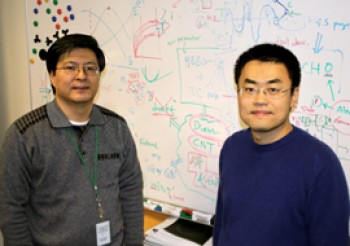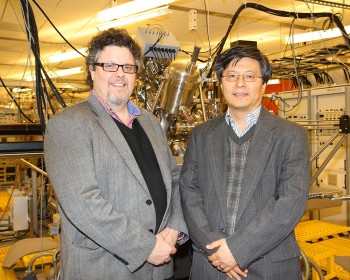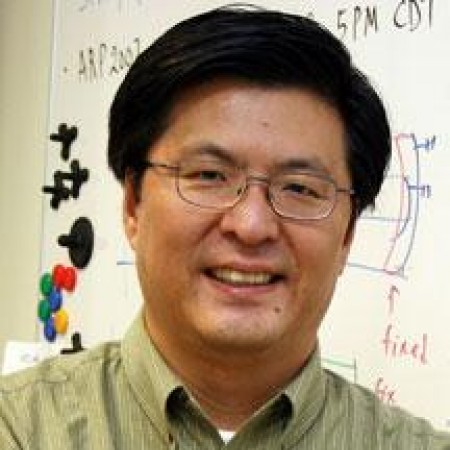Ph.D. - Physics
Massachusetts Institute of Technology - 1994
Professional Preparation
M.S. - Physics
Seoul National University, Korea - 1988
Seoul National University, Korea - 1988
B.S. - Physics
Seoul National University, Korea - 1986
Seoul National University, Korea - 1986
Research Areas
Nanomaterials for renewable energy application
Limited supply of fossil fuels and environmental pollution issues require renewable energy technology using hydrogen as energy carriers. Three key technology components are hydrogen production, storage, and utilization in fuel cells. At the core of the renewable energy technology research is new materials to convert energy from one form to another (e.g., photon energy to electricity in solar cell, or chemical energy to electricity in fuel cell). There are extensive research efforts to develop new nanomaterials with higher efficiency in the energy conversion and optimized functional properties, but most of them are driven by empirical trial-and-error material development process. Computational modeling can provide detailed understanding on the microscopic mechanisms and properties nanomaterials for diverse applications. Our research is to apply molecular dynamics and Monte Carlo simulations to identify atomic structures of nanoscale materials and use quantum simulations to investigate functional properties through electronic structure analysis. Target materials systems are carbon nanotubes, semiconductor nanowires, metal nanoparticles, and oxide nanomaterials in diverse functional nanocomposite nanomaterials.High-k gate stack technology
Device scaling is leading to sub 32nm device feature size and continuous scaling requires new device materials such as high-k gate dielectric (replacing silica), metal gate electrode (replacing doped poly-silicon), and high mobility channel materials (e.g., Ge or compound semiconductors replacing silicon). These new device materials form interfaces and the interface properties critically control the device performance. These interfaces are very thin (nm scale), and computational modeling can provide critical insight to solve many technological challenges in developing the high-k gate stack as future device technology. Our research will apply atomistic modeling method to determine the atomic structure of the interfaces and quantum mechanical simulations to calculate the electronic structures. The analysis of simulation results would provide detailed insights on the nano-scale structure-property relationship of high-k gate stack materials.Research Interests
Computational modeling study of nanomaterials with applications to nanoelectronic devices and renewable energy technology.Publications
Zhao, M., W. Xiao, H. Zhang, and K. Cho, Graphene - Ni (001) interface study, Physical
Chemistry Chemical Physics (in press). forthcoming - Publication
Zhang, H., G. Lee and K. Cho. Thermal Transport in Graphene and Effects of Vacancy
Defects. Physical Review B (in review). forthcoming - Publication
Wang, W., C. Gong, B. Shan, R.M. Wallace, and K. Cho. Sulfur Passivation Effect on
HfO2/GaAs Interface: A First-Principles Study. Applied Physics Letters (in review). forthcoming - Publication
Xiong, K., W. Wang, R.P. Gupta, B.E. Gnade and K. Cho, Electronic structures and
stability of group VA impurities in lead telluride. Journal of Physics D: Applied Physics (in
review). forthcoming - Publication
Chen, R., Z.Z. Chen, B. Ma, X. Hao, N. Kapur, J. Hyun, K. Cho, and B. Shan. CO
Adsorption on Pt(111) and Pd(111) Surfaces: A First-Principles Based Lattice Gas MonteCarlo Study. Computational and Theoretical Chemistry (in review). forthcoming - Publication
Wang, W., P.-R. Cha, S, Lee, G. Kim, M.J. Kim, and K. Cho, First Principles Study of Si
Etching by CHF3 Plasma Source. Applied Surface Science (in press). forthcoming - Publication
Bhatt, M., M. Cho, and K. Cho, Conduction of Li
+
cations in Ethylene Carbonate (EC) and
Propylene Carbonate (PC): Comparative Studies using Density Functional Theory. Journal
of Solid State Electrochemistry (in press). forthcoming - Publication
Wang, W., G. Lee, M. Huang, R.M. Wallace, and K. Cho. First-Principles study of GaAs
(001)-2(2x4) surface oxidation, Microelectronic Engineering (in press). forthcoming - Publication
News Articles
Prof's Theory Could Improve Shelf Life of Electronics
 Research by UT Dallas engineers could lead to more efficient cooling of electronics, which would pave the way for quieter and longer-lasting computers, cellphones and other devices. Much of modern technology uses silicon as semiconductor material. But research recently published in the journal Nature Materials shows that graphene conducts heat about 20 times faster than silicon. The Nature Materials paper incorporates the findings of researchers at UT Austin, who conducted an experiment focused on graphene’s heat transfer. They used a laser beam to heat the center of a portion of graphene, then measured the temperature difference from the middle of the graphene to the edge. Cho’s theory helped explain their results. The Nature Materials experiment was done in collaboration with Shanshan Chen and Weiwei Cai of Xiamen University in Xiamen China and UT Austin; Qingzhi Wu, Columbia Mishra and Rodney Ruoff of UT Austin; Junyong Kang also of Xiamen University; and Alexander Balandin of the University of California, Riverside.
Research by UT Dallas engineers could lead to more efficient cooling of electronics, which would pave the way for quieter and longer-lasting computers, cellphones and other devices. Much of modern technology uses silicon as semiconductor material. But research recently published in the journal Nature Materials shows that graphene conducts heat about 20 times faster than silicon. The Nature Materials paper incorporates the findings of researchers at UT Austin, who conducted an experiment focused on graphene’s heat transfer. They used a laser beam to heat the center of a portion of graphene, then measured the temperature difference from the middle of the graphene to the edge. Cho’s theory helped explain their results. The Nature Materials experiment was done in collaboration with Shanshan Chen and Weiwei Cai of Xiamen University in Xiamen China and UT Austin; Qingzhi Wu, Columbia Mishra and Rodney Ruoff of UT Austin; Junyong Kang also of Xiamen University; and Alexander Balandin of the University of California, Riverside.
New Material May Help Cut Battery Costs for Electric Cars, Cellphones
 In the battle of the batteries, lithium-ion technology is the reigning champion, powering that cellphone in your pocket as well as an increasing number of electric vehicles on the road.
In the battle of the batteries, lithium-ion technology is the reigning champion, powering that cellphone in your pocket as well as an increasing number of electric vehicles on the road. But a novel manganese and sodium-ion-based material developed at The University of Texas at Dallas, in collaboration with Seoul National University, might become a contender, offering a potentially lower-cost, more ecofriendly option to fuel next-generation devices and electric cars.
Battery cost is a substantial issue, said Dr. Kyeongjae Cho, professor of materials science and engineering in the Erik Jonsson School of Engineering and Computer Science and senior author of a paper describing the new material in the journal Advanced Materials.
Jonsson School Team Charges Ahead to Develop Better Batteries
 They die at the most inconvenient times.
They die at the most inconvenient times.Cellphones go dark during important conversations because a battery hasn’t been recharged. Or the automotive industry revs up with excitement for a new battery-powered vehicle, but it needs frequent recharging. Or yardwork is delayed because the battery for your string trimmer is dead.
Researchers at The University of Texas at Dallas have developed a high-powered, environmentally safe lithium-sulfur substitute that could drastically lengthen battery life. Their work has been published in the journal Nature Nanotechnology.
Discovery Could Energize Development of Longer-Lasting Batteries
A UT Dallas researcher has made a discovery that could open the door to cellphone and car batteries that last five times longer than current ones.Dr. Kyeongjae Cho, professor of materials science and engineering in the Erik Jonsson School of Engineering and Computer Science, has discovered new catalyst materials for lithium-air batteries that jumpstart efforts at expanding battery capacity. The research was published in Nature Energy.
“There’s huge promise in lithium-air batteries. However, despite the aggressive research being done by groups all over the world, those promises are not being delivered in real life,” Cho said. “So this is very exciting progress. (UT Dallas graduate student) Yongping Zheng and our collaboration team have demonstrated that this problem can be solved. Hopefully, this discovery will revitalize research in this area and create momentum for further development.”
Scientists Dramatically Increase Light from Atomic-Sized Materials
 A recent article in the journal Science details how researchers from the Erik Jonsson School of Engineering and Computer Sciencedevised a simple process that dramatically increases light generation from certain atomic-sized materials.
A recent article in the journal Science details how researchers from the Erik Jonsson School of Engineering and Computer Sciencedevised a simple process that dramatically increases light generation from certain atomic-sized materials.The findings could have a broad impact in the advancement of LED displays, high efficiency solar cells, photo detectors, and nano-electronic circuits and devices.
